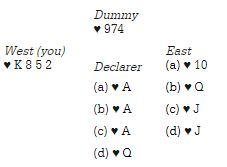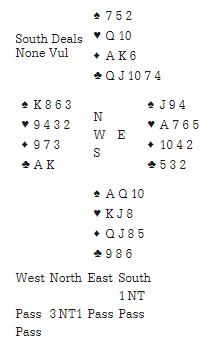Source: www.andrewrobson.co.uk
You have led low and dummy has only low cards. Because the third player should play high, but cheaper of touching highest cards, you can draw huge inferences.
Exercise:
What can you as West work out about the location of the missing honours in each case?
- (a) Declarer would not win
 A unless he had to, so East must have
A unless he had to, so East must have  QJ, entirely consistent with his play of
QJ, entirely consistent with his play of  10, cheaper of equals.
10, cheaper of equals.
- (b) East would have played
 J if he had it, so declarer has
J if he had it, so declarer has  J.
J.
- (c) Declarer would have won
 Q if he had it. Therefore East has
Q if he had it. Therefore East has  Q. As to
Q. As to  10, East would have played the cheaper card from
10, East would have played the cheaper card from  QJ10, so declarer must have it.
QJ10, so declarer must have it.
- (d) Partner would have played
 A (third hand high) if he had it. So declarer has
A (third hand high) if he had it. So declarer has  A. Declarer must also have
A. Declarer must also have  10, or partner would have played the cheaper
10, or partner would have played the cheaper  10 (rather than
10 (rather than  J).
J).

- Upgrading, given the sequentially rich five-card suit.
What happened
West led

3 vs 3NT, and Trick One went

3,

2,

J,

Q. At Trick Two declarer led

9, and West won

K. He then led

6. Declarer won

10 and drove out

A. West persevered with

8, but declarer could win

A and cash his minor-suit winners. Game made plus one.
What should have happened
Trick One reveals to West that declarer holds

A (partner would have played

A as third hand high if he held the card). It also reveals that declarer holds

10 – East would have played the cheaper

10 from

J10. So when at Trick Two West wins

K, he must not lead a second spade, rather try to put East on play for a spade through declarer’s known

A10. Looking at dummy, it is clear for West to switch to hearts (the weakness), and he selects

9, as a high for hate lead. East wins

A and reverts to

9 (top from two remaining). West beats declarer’s

10 with

K, returns

6 to

A, then wins the second club with

A and cashes

8. Down one.
If you remember one thing…
Partner’s third hand play (high but cheaper of touching highest) can tell the leader a huge amount about the layout of the suit.


 A unless he had to, so East must have
A unless he had to, so East must have  QJ, entirely consistent with his play of
QJ, entirely consistent with his play of  10, cheaper of equals.
10, cheaper of equals. J if he had it, so declarer has
J if he had it, so declarer has  J.
J. Q if he had it. Therefore East has
Q if he had it. Therefore East has  Q. As to
Q. As to  10, East would have played the cheaper card from
10, East would have played the cheaper card from  QJ10, so declarer must have it.
QJ10, so declarer must have it. A (third hand high) if he had it. So declarer has
A (third hand high) if he had it. So declarer has  A. Declarer must also have
A. Declarer must also have  10, or partner would have played the cheaper
10, or partner would have played the cheaper  10 (rather than
10 (rather than  J).
J).




























